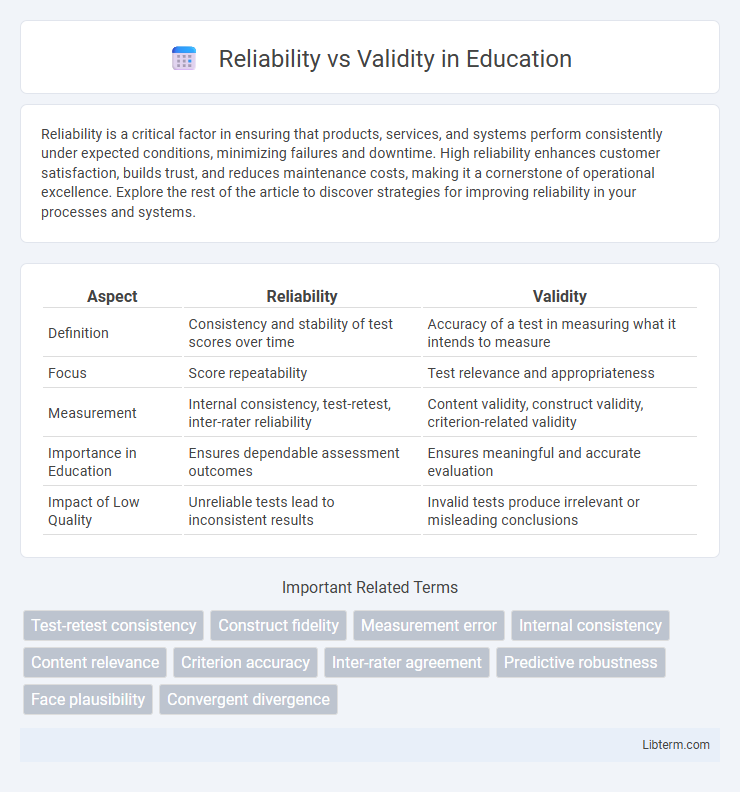Reliability is a critical factor in ensuring that products, services, and systems perform consistently under expected conditions, minimizing failures and downtime. High reliability enhances customer satisfaction, builds trust, and reduces maintenance costs, making it a cornerstone of operational excellence. Explore the rest of the article to discover strategies for improving reliability in your processes and systems.
Table of Comparison
| Aspect | Reliability | Validity |
|---|---|---|
| Definition | Consistency and stability of test scores over time | Accuracy of a test in measuring what it intends to measure |
| Focus | Score repeatability | Test relevance and appropriateness |
| Measurement | Internal consistency, test-retest, inter-rater reliability | Content validity, construct validity, criterion-related validity |
| Importance in Education | Ensures dependable assessment outcomes | Ensures meaningful and accurate evaluation |
| Impact of Low Quality | Unreliable tests lead to inconsistent results | Invalid tests produce irrelevant or misleading conclusions |
Understanding Reliability: Definition and Importance
Reliability refers to the consistency and stability of a measurement or test over time, ensuring that repeated assessments yield similar results. High reliability is crucial for producing dependable data in research, enabling accurate replication and comparison across studies. Understanding reliability helps researchers identify measurement errors and improve the precision of instruments in fields such as psychology, education, and healthcare.
Defining Validity: What Does It Mean?
Validity refers to the accuracy with which a test or measurement tool measures what it is intended to measure, ensuring the results are meaningful and relevant. It encompasses various types, such as content validity, which assesses the extent to which the test covers the representative content, and construct validity, which evaluates whether the test truly reflects the theoretical construct. High validity guarantees that conclusions drawn from data accurately reflect the real-world phenomenon under investigation.
Key Differences Between Reliability and Validity
Reliability refers to the consistency and repeatability of measurement results across different occasions or observers, ensuring stability over time. Validity measures the accuracy and truthfulness of a test or instrument in capturing the intended concept or construct. While reliability is necessary for validity, a measurement can be reliable without being valid, highlighting that consistent results do not guarantee correctness or relevance.
Types of Reliability in Research
Types of reliability in research include test-retest reliability, which assesses the consistency of results over time; inter-rater reliability, measuring the degree of agreement between different observers; and internal consistency reliability, evaluating the correlation among items within a test. High reliability ensures that measurement instruments yield stable and consistent results, crucial for replicability and accuracy in research findings. Understanding and selecting the appropriate type of reliability strengthens the overall validity and credibility of a study's data.
Categories of Validity in Measurement
Validity in measurement encompasses content validity, ensuring the test covers the entire domain of the concept; construct validity, which assesses whether the tool accurately measures the theoretical construct; and criterion-related validity, involving predictive and concurrent validity to evaluate how well one measure forecasts or correlates with an outcome. Each category addresses distinct aspects of validity, crucial for determining the accuracy and meaningfulness of measurement instruments in research and applied settings. Ensuring strong validity in these categories guarantees that results are not only consistent but also truly representative of the intended variables.
Relationship Between Reliability and Validity
Reliability refers to the consistency of a measurement, while validity assesses whether the measurement accurately reflects the intended concept. A measurement can be reliable without being valid, but it cannot be valid unless it is reliable. High reliability is a necessary foundation for validity, as inconsistent data undermines the accuracy of conclusions drawn from the measurement.
Factors Affecting Reliability and Validity
Reliability and validity are influenced by factors such as measurement consistency, instrument precision, and testing conditions; reliability depends on the repeatability of results under similar circumstances, while validity hinges on the accuracy of measuring the intended construct. Participant variability, environmental influences, and observer bias can reduce reliability by introducing inconsistencies, whereas poor operational definitions, inadequate sampling, and irrelevant content affect validity by compromising the relevance and truthfulness of findings. Ensuring standardized procedures, clear definitions, and representative samples optimizes both reliability and validity in research outcomes.
Methods to Improve Reliability and Validity
Enhancing reliability involves consistent measurement techniques, such as standardized procedures, repeated trials, and thorough training for data collectors to minimize variability. Improving validity requires ensuring that the methods accurately capture the intended construct through pilot testing, using multiple measurement approaches, and refining instruments based on expert feedback. Employing both reliability and validity checks, including statistical analyses like Cronbach's alpha for internal consistency and factor analysis for construct validity, strengthens overall research quality.
Real-World Examples: Reliability vs Validity
In engineering, a bridge that consistently supports a heavy load without failure demonstrates high reliability, while its validity is shown by accurately serving its intended purpose of safe transportation. In psychological testing, a personality test yields reliable outcomes if it produces consistent results over time, whereas validity is evidenced when the test genuinely measures personality traits rather than unrelated factors. Medical diagnostics illustrate reliability when a blood pressure monitor provides consistent readings, and validity when it accurately measures actual blood pressure levels relevant to patient health.
Conclusion: Balancing Reliability and Validity in Research
Balancing reliability and validity is crucial for robust research outcomes, as reliability ensures consistency while validity guarantees accuracy in measuring what is intended. Prioritizing both elements reduces measurement errors and enhances the credibility of study results. Researchers must design methods that optimize this balance to produce trustworthy and meaningful data.
Reliability Infographic

 libterm.com
libterm.com